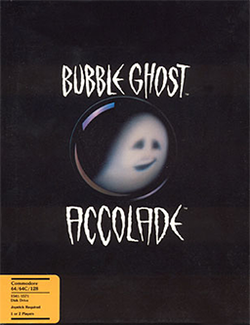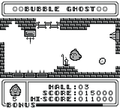Bubble Ghost
This article possibly contains original research. (May 2011) |
| Bubble Ghost | |
|---|---|
 | |
| Developer(s) | Christophe Andreani (ST version) Infogrames (all other versions) Pony Canyon (Game Boy version) |
| Publisher(s) | ERE Informatique (France) Infogrames (UK, Europe) Accolade (USA) Pony Canyon (Japan) |
| Designer(s) | Christophe Andreani |
| Composer(s) | Hitoshi Sakimoto (GB version) |
| Engine | C, assembly language |
| Platform(s) | Atari ST, Amiga, Amstrad CPC, Commodore 64, DOS, Apple IIGS, Game Boy |
| Genre(s) | Arcade |
| Mode(s) | Single-player, Two-player |
Bubble Ghost is a French 1987 video game created by Christophe Andreani and published by ERE Informatique.
Gameplay
Bubble Ghost is a 2D arcade game. The player controls the ghost using the computer mouse and makes him blow at a bubble. The objective is to guide a bubble throughout a number of halls in a haunted house. If the bubble hits any walls or obstacles, then it will pop and the player loses a life. Obstacles include lit candles, electricity and fans. These can be all controlled by the ghost, who can wander around the level freely and blow at things - such as the bubble to add speed, the candle to put out the flame, or switches to turn them on or off.
The ghost is controlled using the mouse: moving the mouse moves the ghost. A press on the left button of the mouse makes the ghost rotate to the left. A press on the right button of the mouse makes the ghost rotate to the right. A press on a keyboard key (Shift) makes the ghost blow.
The game is made of 35 halls (levels). Each time the player makes the bubble exit a hall, he wins 1000 points + left bonus. Action on animation may add 5000 points to the player. The bonus is re-initialized at every new hall. A new bubble is added to the player account each time the bubble exits towards the top of the hall.
Releases
The original Bubble Ghost was created by Christophe Andreani (design, programming) on an Atari ST computer. The game has been adapted for other computers throughout the world.
Some years later, ERE Informatique was bought by Infogrames. Infogrames published a new version of Bubble Ghost with updated graphics, Bubble + (Bubble Plus).
A Nintendo Game Boy version was published in 1990. It was the first French game adapted for the Game Boy. [citation needed]
The original concept of Bubble Ghost was reused and modified in 2008 in the game Soul Bubbles for the Nintendo DS. [citation needed]
Miscellaneous
Some graphic parts of the Bubble Ghost halls have a specific meaning:
Hall #4: An advertisement for the French telematics server Pinky by Godefroy Troude, and a wink to the video game Mercenary by Paul Woakes published by Novagen.
Hall#5: The face of the author slightly modified.
Hall#11: The face of the author appears with glasses (if the ghost is blowing in the ear, glasses disappear) and a wink at the video game The Pawn published by Rainbird.
Hall#15: Another wink to the video game Mercenary by Paul Woakes published by Novagen.
Hall#28: Two more winks to the video game The Pawn published by Rainbird.
Gallery
-
Bubble Ghost, Atari ST version, Hall#4
-
Bubble Ghost, Atari ST version, Hall#5
-
Bubble Ghost, Atari ST version, Hall#9
-
Bubble Ghost, Game Boy version, Hall#3
Technical information
The game was programmed in C (editor and compiler: Megamax C) and 68000 assembly language on an Atari 1040 ST computer. The graphics were made with the Degas Elite drawing software. The digital sound of the introductory page of the game ("Welcome to Bubble Ghost") was built using ST Replay. This is the author’s voice. The other sound effects use the synthesizer inside the Atari ST.
Here are some notes from the author when creating the game:
-
Bubble Ghost, levels order
-
Bubble Ghost, hall#9 design
-
Bubble Ghost, ghost and bubble animation
-
Bubble Ghost, game technical notes
Press
Following French magazines have published Bubble Ghost review:
- SVM Science et Vie Micro #45, December 1987 (Atari ST version) Download magazine
- Tilt #49, December 1987 (Atari ST version) Download magazine
- ST Magazine #14, November/December 1987 (Atari ST version) Download magazine
- Micro News #6, November/December 1987 (Atari ST version)
- Le Tatou #10, December 1987 (Atari ST version)
- 1ST (FirST) #4, December 1987 (Atari ST version) Download magazine
- Jeux et Stratégie #48, December 1987 (Atari ST version)
- Génération 4 #2, December 1987 (Atari ST version) Download magazine
- Tilt #52, March 1988 (Amstrad CPC version) Download magazine
- Tilt #57, September 1988 (Amiga version) Download magazine
- Génération 4 Hors série #2, oct/nov/dec 1990 (Game Boy version) Download magazine
- Génération 4 #31, March 1991 (Game Boy version) Download magazine
- Player One #18, March 1992 (Game Boy version) Download magazine
- Joypad #7, April 1992 (Game Boy version) Download magazine
- Consoles + #7, March 1992 (Game Boy version) Download magazine
Following US magazine has published Bubble Ghost review:
- VideoGames and Computer Entertainment, USA, April 1991 (Game Boy version)
- Antic Vol.7 #7, November 1988 (Atari ST version) See review
- ST-Log Issue 24, October 1988 (Atari ST version) See review
- ST-Log Issue 26, December 1988 (Atari ST version) See review
Following French magazines have published Bubble + (Bubble Plus) review:
- Génération 4 #22, May 1990 (Atari ST and Amiga version) Download magazine
- Micro News #35, May 1990 (Atari ST version) Download magazine
- Tilt #79, June 1990 (Atari ST version) Download magazine
External links
- Screenshots of different versions of Bubble Ghost
- Photos of the various packages of Bubble Ghost
- Screenshots of the Game Boy version (French)
- Review and remakes of Bubble Ghost (French)
- Bubble Ghost at MobyGames
- Bubble Ghost on the Amiga at the Hall of Light (HOL)
- Christophe Andréani Internet Website: www.andreani.net








